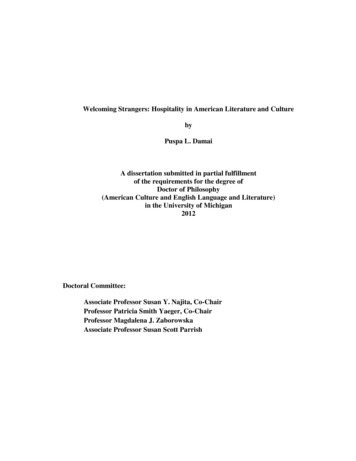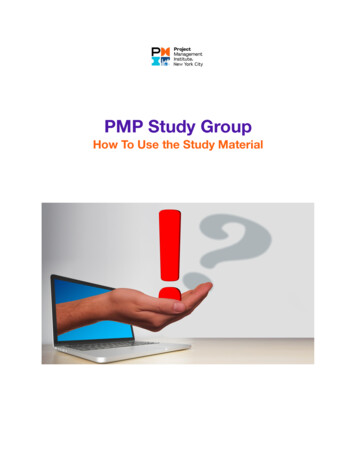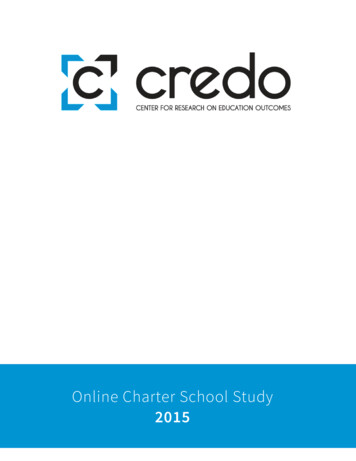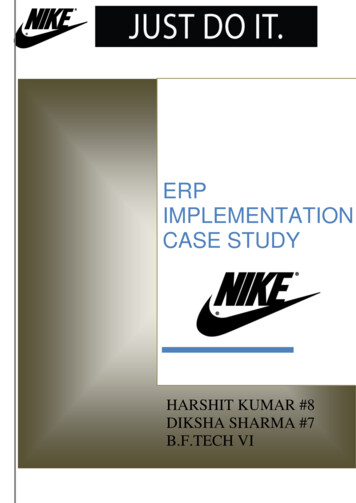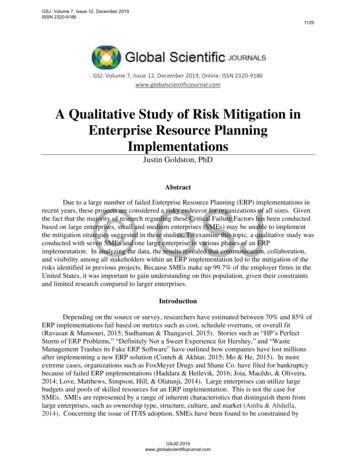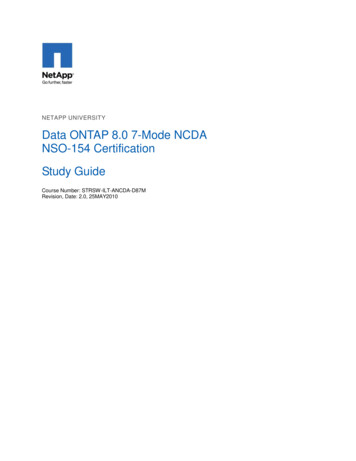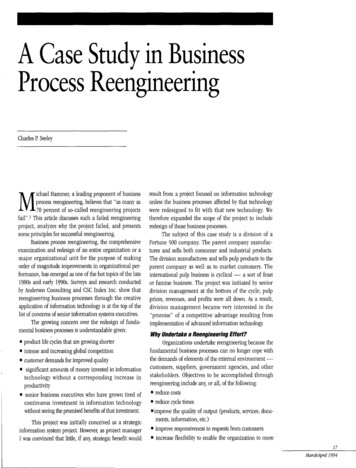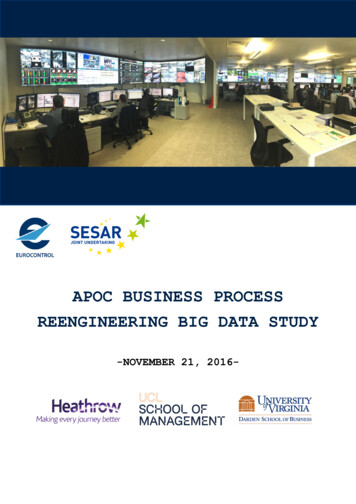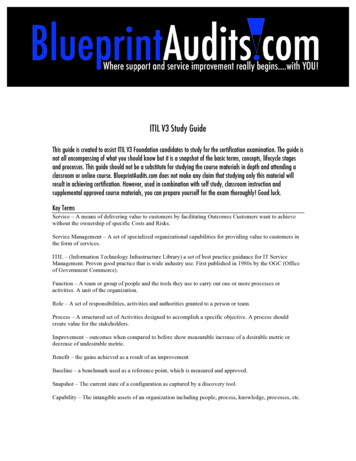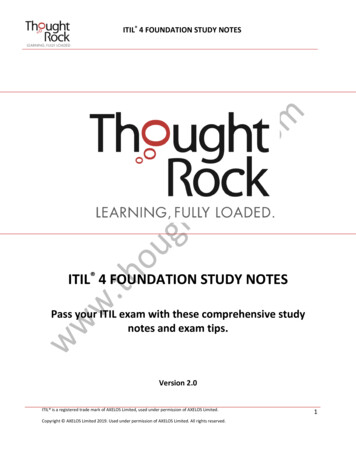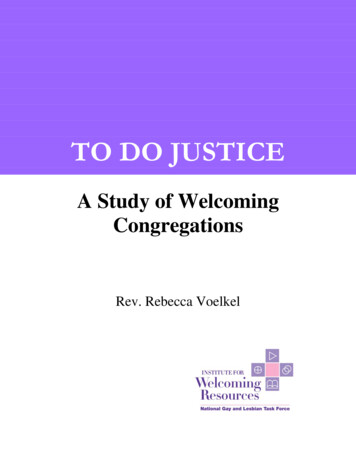
Transcription
TO DO JUSTICEA Study of WelcomingCongregationsRev. Rebecca Voelkel
ACKNOWLEDGEMENTSThis study would not have been possible without the support of theleaders of the Welcoming Church Programs whose membercongregations I surveyed: Dr. Michael Adee—More Light Presbyterians in thePresbyterian Church (USA)Kerry Armstrong—Open & Affirming Program of Gay andLesbian Affirming Disciples in the Christian Church(Disciples of Christ)Meredith Bischoff—Welcoming Community Network in theCommunity of ChristJohn Clinton Bradley—IntegrityUSA in the EpiscopalChurch USAEmily Eastwood—Reconciling in Christ Program in theEvangelical Lutheran Church in America and the EvangelicalLutheran Church in CanadaRev. Ruth Garwood—Open and Affirming Program of theUnited Church of Christ Coalition for LGBT ConcernsRev. Dr. Sally Harris—Affirm United/S’affirmer ensemble inthe United Church of CanadaRev. Keith Kron—Unitarian Universalist Association Officeof BLGT ConcernsRev. Ken Pennings—Association of Welcoming andAffirming Baptists in the American Baptist Churches and theAlliance of BaptistsRev. Troy Plummer of the Reconciling Ministries Network inthe United Methodist ChurchRev. Elder Nancy Wilson—Universal Fellowship ofMetropolitan Community ChurchesRev. Carol Wise—Supportive Community Network of theBrethren Mennonite Council for LGBT InterestsI also need to thank my esteemed colleagues at the National Gay andLesbian Task Force: David Lohman for his careful editing; Dr. JaimeGrant, Somjen Frazer and Amanda Morgan for counsel and supportin analyzing data; Pedro Julio Serrano for communication expertiseand Rev. Darlene Nipper for guidance.Additionally, Rev. Debra Haffner and Timothy Palmer of theReligious Institute on Sexual Morality, Justice and Healing, and Dr.Robert Jones consulted and offered creative critique and feedbackwithout which this study would not have been possible. 2009 National Gay and Lesbian Task Force2
TABLE OF CONTENTSExecutive Summary . 4Introduction . 6Analysis:The Welcoming Process Creates andSupports an Environment for Justice . 8Welcoming Congregations Exhibit LowLevels of Conflict . 10Theological Reflection . 12Conclusion . 143
TO DO JUSTICEA Study of Welcoming Congregations1EXECUTIVE SUMMARYThe past twenty-five years have seen exponential growth of Christian and UnitarianUniversalist congregations that have named themselves Welcoming of persons of allsexual orientations and gender identities.2 This growth is the result of prayerful,intentional work by clergy and lay leaders within local congregations and by leadersof Welcoming Church Programs within many denominations.3 The fruit of thislabor is a vibrant and growing movement that has helped congregations becomemore vital, less conflicted and more focused on their mission of hospitality andjustice.In reaction to this growth and vibrancy, an equally intentional but more covert efforthas arisen to attempt to quash the power of the Welcoming Programs and toadvocate for homophobic, trans-phobic and heterosexist Church policy.4The title of this report is taken from Micah 6:8 And what does God require of you but to do justice, to love kindness andto walk humbly with your God. The use of the language of “Welcoming” refers to congregations that have gonethrough an intentional process regarding their welcome of lesbian, gay, bisexual and transgender (LGBT) personswhich includes education, a vote and a public statement of welcome. These congregations are recognized and“rostered” or listed by an outside organization—usually a “Welcoming Church Program” which operates within aparticular tradition. For example, the Reconciling Ministries Network rosters congregations within the UnitedMethodist Church. Each program has its own language for a Welcoming congregation—“Reconciling,” “Openand Affirming,” “Welcoming and Affirming,” etc. It is important to note that many of these Welcoming ChurchPrograms are over twenty years old and the criteria for Welcome have changed. Therefore, some of thecongregations that are listed have only done intentional educational work around lesbian and gay persons. Eachof the welcoming programs is working with those congregations that have not engaged transgender issues to doso. In particular, the Institute for Welcoming Resources’ new resource transACTION is currently being used todo such educational processes.A free downloadable version of the curriculum is available atwww.WelcomingResources.org.1In the last five years alone, the number of publicly Welcoming congregations listed on the National Gay andLesbian Task Force’s Institute for Welcoming Resources website (www.WelcomingResources.org) has grownalmost three-fold. While an official Welcoming Program does not currently exist in other religious traditions, aproject within the five major movements of Judaism (Orthodox, Conservative, Reform, Reconstructionist andRenewal) is in the planning and testing phases.23For a list of these programs, see Acknowledgements.One of the prime movers in this anti-welcoming movement is the Institute on Religion and Democracy (IRD).Using largely secular money sources and covert community organizing techniques, the IRD has sought todismantle denominations (American Baptist Churches), take over leadership (Southern Baptist Churches) orsignificantly disrupt the welcoming gains in many denominations (the United Methodist Church, the UnitedChurch of Christ and the Presbyterian Church (USA)). There are several books documenting these phenomenaincluding Howell, Leon, United Methodism @ Risk: A Wake-Up Call, [Kingston, NY: Information Project forUnited Methodists, 2003] and Culver, Sheldon, and John Dorhauer, Steeplejacking: How the Christian Right isHijacking Mainstream Religion, [Brooklyn: IG Publishing, 2007].44
EXECUTIVE SUMMARY (continued)In order to both highlight the vibrancy, faithfulness and power of the WelcomingMovement and to counter the “false witness” of those who seek to quash thismovement of hospitality and justice, the Institute for Welcoming Resources of theNational Gay and Lesbian Task Force surveyed pastors and leaders of 1,200Welcoming congregations to ask them about their work and witness.Two areas emerged that warrant particular focus and celebration:Successfully completing a WelcomingProcess makes a congregation morelikely to work and witness on otherjustice issues.Congregations that directly engage thequestion of welcoming lesbian, gay,bisexual and transgender (LGBT)persons have low levels of conflict.5
INTRODUCTIONIn April and May of 2008, the National Gay and Lesbian Task Force’s Institute forWelcoming Resources surveyed the pastors of 1,200 Welcoming congregations listedon our website: www.WelcomingResources.org.Although we list over 3,200congregations, these 1,200 were chosen because they were affiliated with aWelcoming Church Program whose leader had agreed to write a letter requesting thecompletion of the survey. We received 364 respondents, for a return rate slightlyhigher than 30%.We engaged this research because there exist very few studies on Welcomingcongregations and pastors. With the exception of Rev. Dr. Jane Heckles’ 1997 study,Stewardship Trends in Open & Affirming Churches of the United Church of Christ and,perhaps one other in the Lutheran tradition, Welcoming congregations have notbeen the subject of analysis.5 And yet, much of the life in Progressive Christianityemerges from those congregations which have engaged a formal WelcomingProcess.6 Why are Welcoming congregations seemingly so healthy and engaged?This was one of our guiding questions.Beginning the study, we were working under two assumptions that were borne fromanecdotal evidence:1. Congregations appear generally stronger, healthier and more faithfulbecause of having successfully completed a Welcoming Process.2. Welcoming congregations seem to find that the experience of aWelcoming Process leads to an awareness and action around other socialjustice issues.5Heckles, Jane, Stewardship Trends in Open & Affirming Churches of the United Church of Christ, [Doctor of MinistryThesis, Andover-Newton Theological Seminary: Newton Centre, MA, 1997].Progressive Christianity embodies “an understanding of Christian tradition marked by an awareness of socialsin, a consciousness of institutional and human potential and shortcomings, and an emphasis on the Church’smission to engage the world.” In particular, Progressive Christianity asserts that:a. Christian faithfulness requires public action by churches and people of faith.b. Christian social witness and public action should correspond to accepted practices of deliberativedemocracies.c. The causes of social problems are often structural or systemic. (Peters, Rebecca Todd and ElizabethHinson-Hasty, To Do Justice: A Guide for Progressive Christians, [Westminster John Knox Press, 2008].)66
INTRODUCTION (continued)These assumptions were based in several theological assertions:One of the central tenets of Christianity (that arises from the life and ministry ofJesus and his grounding in Jewish tradition) is that life is stronger than death. Or tosay it another way, that which is about wholeness, fullness, integrity, justice, love, andjoy always, in the end, triumphs over that which is about death-dealing, injustice,brokenness, hatred, fear and violence.Those congregations that engage a Welcoming Process, at some point, have toengage this core tenet. Will they follow what they have learned because of their loveof their brothers, sisters, mothers, brothers, etc who are LGBT or will they be guidedby their fear? Will they allow the cultural messages of hatred to trump the Biblicalimperative for hospitality and justice? Will they allow the “Peter and Corneliusmoment” in which they witness the “fruits of the Spirit” present in LGBT people totriumph over what they believe the tradition says? 7Congregations that engage this central tenet go through a deeply spiritual process. Inmuch the same way that the “coming out” process for LGBT people offers aprofound opportunity for spiritual growth and transformation on an individual level,so does the Welcoming Process on a community-wide level. And this processimpacts not only their openness and affirmation of LGBT people but their entirecongregational life.7Book of Acts, chapter 10.7
ANALYSISThe Welcoming Process Creates and Supports an Environment for JusticeWhen asked, “Has your congregation's work on LGBT issues made your congregation more activeon other justice issues?” over half of the pastors of Welcoming congregations respondedwith a yes. Of those who said their Welcoming Process impacted their work andwitness on other justice issues, they listed disability rights, economic justice,environmental justice, global justice, hate crimes, HIV/AIDS, health care,homelessness, hunger, immigration, community organizing, labor, racial justice,universal human rights, and women’s rights as the areas of their congregationalfocus. The chart below illustrates these areas of focus.Other Justice and Charity WorkDone By Welcoming CongregationsAs you can see, of the Welcoming Congregations that said their Welcoming Processwas connected to work on other justice issues, almost twenty percent of thosecongregations said they also engaged in work around universal human rights, fifteenpercent on work regarding homelessness, just over ten percent working on economicjustice and immigration reform, etc. (Many congregations engaged in more than oneare of other justice work.)8
ANALYSIS (continued)When asked to describe the connections between the LGBT Welcoming Process andwitness on other justice issues, pastors of Welcoming congregations responded asfollows:“We are more open to the plight of the oppressed and marginalized—specially those inpoverty here and around the world. We are small, but we support LWR, the HeiferProject, Equal Exchange, and other programs.” 8“We talk about environmental stewardship. As the pastor at this small, missioncongregation in a very conservative town, when asked about my stance on LGBT inclusionin the church, I bring up the fact that it—along with such things as being stewards ofcreation—is part of what it is to be a person of faith (we are to hold up the personhood ofothers).”“We now work with a homeless day shelter it was through working with a young manwith AIDS that the church found a face that they could reach out to and now are reachingout to homeless people.”“We now have an active advocacy program involving 25 people for hunger and justice inour state government.”“We have a very strong outreach now, led by LGBT people in part, to impoverishedelderly, both gay and straight.”This data highlights a crucial, three-fold reality:1. Engaging an official process of Welcoming provides a local congregationthe opportunity to clarify their theology, mission and life of faith.2. This clarity often requires the congregation to choose between fear (ofloss of membership, conflict, outside perceptions, etc.) and the kind oflife and faith that takes appropriate risks.3. Choosing life and faith often results in the same kind of appropriate risktaking in other areas that might induce fear (immigration, racial justice,etc.).Thus, the Welcoming Process, when done well, is a deeply spiritual process for acongregation whose impact is felt far beyond LGBT issues.Welcomingcongregations become spiritual communities whose work and ministry are morefaithful to the breadth and depth of the heart of religious vocation—helping to remake the world as God would have it to be—more just and equitable and joyous—for ALL created persons and beings.Lutheran World Relief is a denominationally supported organization that addresses glo
A free downloadable version of the curriculum is available at www.WelcomingResources.org. 2 In the last five years alone, the number of publicly Welcoming congregations listed on the National Gay and Lesbian Task Force’s Institute for Welcoming Resources website (www.WelcomingResources.org) has grown almost three-fold. While an official Welcoming Program does not currently exist in other .File Size: 214KBPage Count: 14
